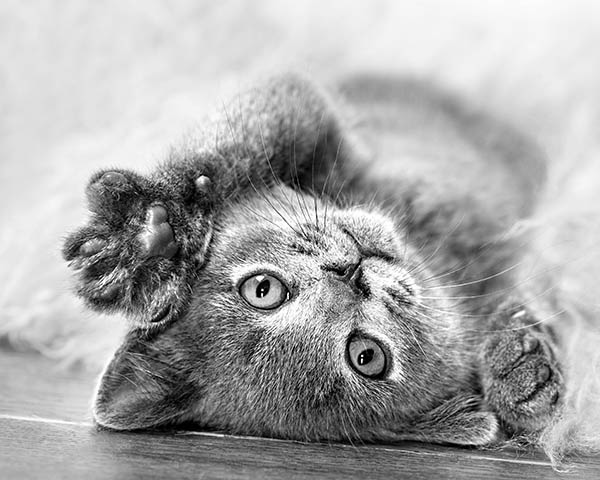What does healthy cat poo look like?
It’s important to keep an eye on your cat’s poo to make sure they’re healthy. When your cat has finished doing its business, quickly check the litter tray before emptying it out.
Cat poo should be firm, well-formed logs that are brown in colour. When you scoop it up, there should ideally be no residue in the litter box. The volume of stool should also equal the amount of food your cat consumes.
Once you become familiar with normal cat poo, you’ll notice if there’s a sudden change in colour, texture, regularity and smell. These could all point to signs of illness or health conditions.
Cat poo colours and what they mean
When you dig around in the litter tray, you might come across all sorts of colours. Understanding the different colours of cat poo can help you determine what they mean, and what to do next.
Brown cat poo
Brown cat poo is a sign that your cat is in tip-top shape. This means they are getting the necessary nutrients from their food. The shade of brown can vary depending on diet or eating habit. For example, light brown cat poo can indicate that food hasn’t digested properly.
Black cat poo
Cat poo that is black in colour could suggest internal bleeding issues – especially in the upper gastrointestinal tract. Blood that has been digested usually has a black appearance that coats the stool. If your cat has very dark or black poo, seek advice from your vet.
White cat poo
White cat poo is rare, but it could be quite serious. This indicates a blockage in the passage that connects the liver, gallbladder and small intestine. Cats with this issue may experience a lack of appetite, lethargy or vomiting. In this case, contact your vet immediately.
Yellow cat poo
Yellow or green cat poo can suggest that your cat is passing stool too quickly. This could stem from bacterial infection, intestinal parasites or liver or gallbladder issues. Consult your vet for a diagnosis and necessary treatment.
Grey cat poo
Grey cat poo indicates a lack of bile or probiotics in your cat’s system. This can be the result in food changes in your cat’s diet . In some cases, it may point to signs of overfeeding and bowel irritation. If you have any concerns, seek advice from your vet.
Cat poo textures and what they mean
From small, hard pebbles to watery piles, the consistency of your cat’s poo can tell a fascinating story. Ideally, cat poo should be firm but not hard. Log-shaped stools are a great sign, while pellets aren’t.
Hard cat poo
If your cat’s poo is hard and dry, this could be a sign of constipation caused by a lack of fibre or dehydration. Stools with this consistency often come out as pebbles and require some straining. It also leaves no residue when scooped. If you notice hard cat poo in the litter tray, speak to your vet for advice and treatment.
Runny cat poo
Runny or watery cat poo with no defined shape is considered extreme diarrhoea. This can present as flat puddles and is often caused by viruses, intestinal parasites, bacteria or even diet changes. These stools are moist and won’t hold form when scooped. One watery stool isn’t always a cause for concern, but it’s best to monitor this closely. If this continues, seek advice from your vet.
How often should a cat poo?
Not every cat is the same, and the same goes for their bowel movements. Most cats poo about once a day, but it’s also normal for a cat to poo every 12-36 hours. This changes as they get older, and you’ll notice they might not poo as frequently as they did when they were younger.
As a pet parent, you will know what’s normal for your cat. Still, no poo after a couple of days could be an issue. As a general rule, if your cat doesn’t pass a bowel movement for more than two days, ask your vet for advice.
What should kitten poo look like?
Kittens can’t poo or urinate before they’re about three weeks old without their mother’s help. Their stool isn’t drastically different to adult cat poo, but it’s still important to monitor their stool.
Normal kitten poo is pliable and well-formed with a pale-medium brown colour. Because of their sensitive tummies, kittens can easily experience diarrhoea from diet changes or environmental stress.
While kitten poo is softer than adult cat poo, it shouldn’t be mushy. If their stool is softer than the consistency of toothpaste, this could point to dehydration or other health issues.
What about cat poo smell?
It’s normal for cat faeces to have a slight smell – it is poo, after all – but it should be mild and consistent. If you notice it smells significantly worse than normal, this could point to a number of things.
- Diet: A sudden change in diet can disrupt your cat’s digestive system, leading to stronger-smelling poo. Foods rich in protein, such as fish or meat, can also cause your cat’s poo to smell bad.
- Health issues: Foul-smelling poo can indicate several health conditions, such as intestinal parasites, bacterial overgrowth or blood in the gastrointestinal tract.
- Hydration: If your cat is dehydrated, this can lead to more concentrated faeces, resulting in a stronger smell.
Your cat’s poo will never smell like a bed of roses, but cat litter can make those scoops easier. Research different types of litter and decide which is best for your kitty. Whether they’re a spritely kitten or a full-grown feline, training your cat to use a litter box can help prevent offensive smells at home.
Sainsbury’s Bank Pet Insurance
From the litter tray to the garden and beyond, keep tabs on your tabby with cat insurance. We can cover your cat for vet visits, treatment and more. So, if you notice something untoward in their litter box, you can give them the care they need.
Please note that we won't cover any pre-existing conditions and that terms, conditions, excesses, exclusions and limitations apply.
Frequently asked questions
What should cat poo look like?
Normal cat poo should be brown in colour, well-formed and firm, but not hard. When scooped from the litter tray, your cat’s poo should leave little to no residue. Checking the colour and consistency is important to monitoring your cat’s health.
When should I be concerned about my cat’s poo?
A sudden change in your cat’s stool could be a sign of a health condition. If your cat’s poo is white, yellow, black or has an extremely hard or runny consistency, consult your vet immediately.
Why does my kitten’s poo smell so bad?
Diet, environmental changes and even dehydration can cause your cat’s poo to smell bad. In some cases, foul-smelling poo can point to health issue, such as blood in the gastrointestinal tract and intestinal parasites.

Browse our guides
Choose from our list of helpful guides and information

Cat breed guides
How to care for your cat, common health problems and more

Explore dog breeds
Find out how to keep your dog healthy and happy
Terms and conditions
Important Information
* The discount is based on information related to you and the Sainsbury’s and Sainsbury’s Bank transactions linked to your Nectar account. For more information on how we use your data, go to sainsburysbank.co.uk/privacy
Sainsbury's Bank plc, Registered Office, 33 Holborn, London EC1N 2HT (registered in England and Wales, no. 3279730) is authorised by the Prudential Regulation Authority and regulated by the Financial Conduct Authority and the Prudential Regulation Authority (register no. 184514). Sainsbury's Supermarkets Ltd is an appointed representative of Sainsbury's Bank plc.
Sainsbury's Bank plc acts as an introducer to Pinnacle Insurance plc who is authorised by the Prudential Regulation Authority and regulated by the Financial Conduct Authority and the Prudential Regulation Authority (register number 110866). Registered Office: Pinnacle House, A1 Barnet Way, Borehamwood, Hertfordshire, WD6 2XX. Sainsbury’s Bank plc and Pinnacle Insurance plc are not part of the same corporate group.
